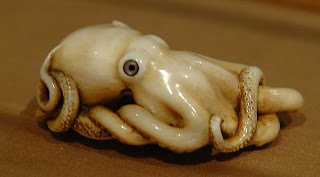A fascinating and very unique art form to Japan is the functional netsuke ("neh-tsu-keh" or sometimes improperly "net-ski") which means "to attach the root." Prior to the 17th Century, the netsuke was a very simple and utilitarian toggle, such as a stone or piece of wood. It did not gain popularity as an art form until the Edo period (17th-19th Century), where it flourished into intricate carvings of animals and figures representing daily life and myths alike.
Until the late 19th Century and early 20th Century, the Japanese wore traditional garments known as kimonos or kosode. Unfortunately for those who wished to carry their personal effects with them, these long robes did not come with pockets. In order to meet this need, the solution was to carry items by way of containers hung from the belt by a silk cord.
The entire suite of cords, netsuke, and container is called a sagemono. An inro is a box, usually intricately carved and decorated, made of several compartments to hold currency, tobacco, and medicines among others. The compartments of the inro are held together by an ojime, a bead like fastener, which slides down the cord to either access or secure the box. The cord is then placed behind the obi, or sash/belt, where it is attached to the button like netsuke hanging over the top of the obi for security.

Intricately carved of ivory or wood, the netsuke usually ranges from about 1 to 2 inches in size. You can distinguish a netsuke from other miniature carvings by the two small connecting holes drilled into it to loop the cord.
There are several styles of netsuke, but the most collectable type is the katabori, which is carved fully in three dimensions. These are prized for their skilled craftsmanship and artistry that developed during the Edo period. Interestingly, while it was the western fashion influence which brought an end to the functional need of the sagemono, and therefore the netsuke, it was also the western interest and recognizing artistry and beauty in the netsukes which made them a collectable item.
After the 1920s, artisans began making netsukes for tourism and commercial purposes. As it is difficult to date ivory, one can make assumptions based on color, patina, imagery, craftsmanship, and functionality. Sometimes the newer items are easier to spot because the carving and artistry is of a lesser quality. As they were not intended for practical use, one can also look for protrusions or breaks that may have been a flaw in the design for functional wear.
Imagery typically ranged from figural, animal, erotic, and mythical. Some examples are below.
Until the late 19th Century and early 20th Century, the Japanese wore traditional garments known as kimonos or kosode. Unfortunately for those who wished to carry their personal effects with them, these long robes did not come with pockets. In order to meet this need, the solution was to carry items by way of containers hung from the belt by a silk cord.
The entire suite of cords, netsuke, and container is called a sagemono. An inro is a box, usually intricately carved and decorated, made of several compartments to hold currency, tobacco, and medicines among others. The compartments of the inro are held together by an ojime, a bead like fastener, which slides down the cord to either access or secure the box. The cord is then placed behind the obi, or sash/belt, where it is attached to the button like netsuke hanging over the top of the obi for security.

Intricately carved of ivory or wood, the netsuke usually ranges from about 1 to 2 inches in size. You can distinguish a netsuke from other miniature carvings by the two small connecting holes drilled into it to loop the cord.
There are several styles of netsuke, but the most collectable type is the katabori, which is carved fully in three dimensions. These are prized for their skilled craftsmanship and artistry that developed during the Edo period. Interestingly, while it was the western fashion influence which brought an end to the functional need of the sagemono, and therefore the netsuke, it was also the western interest and recognizing artistry and beauty in the netsukes which made them a collectable item.
After the 1920s, artisans began making netsukes for tourism and commercial purposes. As it is difficult to date ivory, one can make assumptions based on color, patina, imagery, craftsmanship, and functionality. Sometimes the newer items are easier to spot because the carving and artistry is of a lesser quality. As they were not intended for practical use, one can also look for protrusions or breaks that may have been a flaw in the design for functional wear.
Imagery typically ranged from figural, animal, erotic, and mythical. Some examples are below.






No comments:
Post a Comment